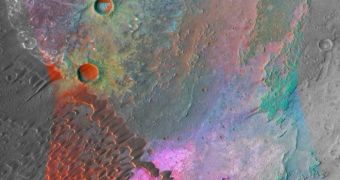Scientists with the Georgia Institute of Technology have determined in a new study that the surface of the Red Planet contains granite, a type of igneous rock that is relatively common here on Earth. This is the first time signs of this material were found on our neighboring world.
The researchers with the team say that previous studies may have underestimated the geological complexity of the Red Planet. It would now seem that it had a much rougher history than previously believed, which led to the creation of numerous types of rock that scientists did not yet detect.
The investigation was led by expert James Wray, who is an assistant professor with the School of Earth and Atmospheric Sciences (SEAS) at Georgia Tech. A paper detailing the findings was published in the November 17 issue of the top scientific journal Nature Geoscience.
The study did not find granite directly, but rather inferred its presence from feldspar, a mineral that is found in granite. Very large amounts of this material were found in ancient Martian volcanoes by the NASA Mars Reconnaissance Orbiter (MRO), which has been surveying the planet since 2006.
The locations were feldspar was found hint at the fact that granite may have been produced in the Red Planet's volcanically-active areas. On Earth, granite is more common in subduction zones, areas of the crust where one tectonic plate slides under another.
“We're providing the most compelling evidence to date that Mars has granitic rocks,” says Wray, who was also the lead author of the journal paper. The work he and his team conducted was sponsored by the NASA Mars Data Analysis Program.
Until now, experts were convinced that Mars had a relatively simple geology, based mostly a type of volcanic rock called basalt, which is very common on Earth on volcanic islands such as Hawaii and Iceland. The new study calls these assumptions into questions, suggesting a wider geological diversity.
“Using the kind of infrared spectroscopic technique we were using, you shouldn't really be able to detect feldspar minerals, unless there's really, really a lot of feldspar and very little of the dark minerals that you get in basalt,” Wray says of the MRO dataset his team used.
Signs of granite on Mars were also uncovered earlier this year by the NASA Mars Science Laboratory (MSL) rover Curiosity. Since scientists had no idea that Mars featured a rich geological history, they preferred to put their findings on hold until further corroboration could be obtained.

 14 DAY TRIAL //
14 DAY TRIAL //